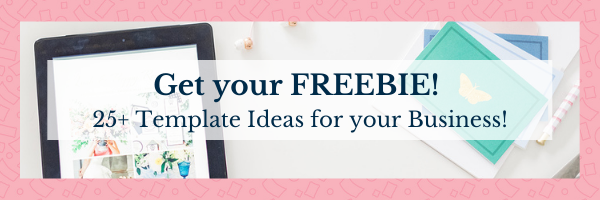How can we, as business owners, work smarter not harder? There are so many answers to that question. One of the biggest time savers is having templates! What are the best places to use templates and how do you keep them from feeling too “robotic”? I’m sharing the biggest reasons why you should be using templates in your business and my top tips for doing so!

How many times have you answered the same questions, typed out the same email, sent the same questionnaire or proposal, etc? How much time does that take to send from scratch each time? Stop wasting time looking for a previous email to tweak or rewrite content about the same thing!
If you share the same content or information a second or third time, it needs to be a template.
Imagine not only having your content ready to go, but better yet – anticipating what your clients need to know. This is one of my favorite things about templates!
Oftentimes, I hear that people are worried templates will feel impersonal and disconnected. Maybe even diminish the client experience. While I completely understand that, there’s a flip side to that perspective that is one of my top reasons to use templates.
ADD VALUE FOR YOUR CLIENTS
If you listen to your clients, you can actually use templates to improve your client experience and anticipate their needs instead of being reactive and answering the same questions all the time. This also adds so much value for your clients. If you’re being proactive and educating them before they think to ask a question, you’re making their experience better and further establishing trust! Bonus: It not only helps them and adds value, but saves both yourself and your clients time, too.
SAVE TIME
In addition to adding value, templates also save both you and your clients time! Just because you don’t auto send something, does not mean that you aren’t saving time. You still are! Taking 2 minutes to add a personal message to an email template or message is much quicker than copy/pasting an email from a previously sent version, proofreading, etc.
HOW TO PERSONALIZE TEMPLATES
Let’s not gloss over the personalization piece. It is important to have intentional communication and relationships with our audience.
How do you use templates, while still being personal with your clients? As a personal brand and business owner, it’s a fine line to strike that balance between efficient and personalized with our audience. We don’t want to spend all day writing emails or creating proposals from scratch. On the other hand, for many of us, that connection with our clients on a deeper, personal level is very important. I’m here to tell you that you can strike that delicate balance!
In order to do that, make sure that your templates leave room for you to add a personal message to them. While this may not be fully automated, it takes much less time to add a quick message about a conversation you had than to write your whole email again. It is also important to be strategic about which communications need to be personalized or not. Some can be a simple reminder email and be fully automated. Whereas your proposals and delivery communications definitely need that personal touch.
WHERE TO USE TEMPLATES
There are a ton of options where you can use templates in your business. Here are a few of the most common ways to use templates in your client facing workflows and communication:
- Emails: Whether it’s an inquiry response, proposal email, welcome email, scheduling sessions or meetings, etc – email templates are the BIGGEST time saver and value add!
- Service/Project Proposals: These can be booking proposals, design proposals, or any type of deliverable that you provide regularly.
- Questionnaires: This includes feedback requests, gathering information for your services (event, project, etc).
- FAQ’s and Experience Guides: Make those e-guides, welcome packets, experience guides and any informational collateral you send regularly into a template. I’m not just referring to the final versions you send to your clients. If you create a lot of free content (e-guides/e-books), make sure you have template layouts you can start from when you go to design them. This will give you brand consistency and save you time!
- Social Media Graphics: Whether it’s Facebook, Instagram (feed, stories, carousel), Pinterest, Blog Posts, headers, etc. Having a few branded templates you can quickly use is so helpful!
- Text reminders: Some of my clients send texts the day before sessions or events to be a bit more personal than email. Having the key information for those texts as a template you can paste and then personalize makes things so quick and easy.
While every business is different and all of those templates may not be best for you, I encourage you to consider whether you have any template gaps. Having as many templates as possible will be a game changer! In addition to having those content pieces saved as templates, are they mapped for use in your workflows?
If so – woot! If not, I suggest spending some time doing so. It will save you time, still allow options for personalization AND provide consistent and thorough communication to all of your clients!
I know it can feel overwhelming to start with templates or even know what you need. So I created the FREEBIE below to help with that!
There are over 25 templates in this list that you should consider for your business! Make sure you get your copy and let me know if there are any others you’ve found super helpful!
xoxo,



LIke it
pin it
tweet it
email it